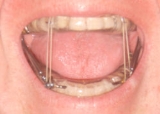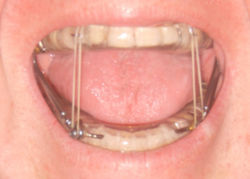
Mandibular advancement splint
Encyclopedia

Mouth
The mouth is the first portion of the alimentary canal that receives food andsaliva. The oral mucosa is the mucous membrane epithelium lining the inside of the mouth....
that is used to treat obstructive sleep apnea
Obstructive sleep apnea
Obstructive sleep apnea or obstructive sleep apnea syndrome is the most common type of sleep apnea and is caused by obstruction of the upper airway. It is characterized by repetitive pauses in breathing during sleep, despite the effort to breathe, and is usually associated with a reduction in...
(OSA) and snoring
Snoring
Snoring is the vibration of respiratory structures and the resulting sound, due to obstructed air movement during breathing while sleeping. In some cases the sound may be soft, but in other cases, it can be loud and unpleasant...
. These devices are also known as "mandibular advancement devices," "sleep apnea oral appliances," and "sleep apnea mouth guards."
The splint treats snoring and sleep apnea by moving the lower jaw forward slightly, which tightens the soft tissue and muscles of the upper airway to prevent obstruction of the airway during sleep. The tightening created by the device also prevents the tissues of the upper airway from vibrating as air passes over them – the most common cause of loud snoring.
Mandibular advancement splints are widely used in the United States
United States
The United States of America is a federal constitutional republic comprising fifty states and a federal district...
and are beginning to be used in Britain and Israel
Israel
The State of Israel is a parliamentary republic located in the Middle East, along the eastern shore of the Mediterranean Sea...
. Where appropriate, they are considered a good therapy choice as they are non-invasive, easily reversible, quiet, and generally well accepted by the patient. The focus of improvement in appliance design is in reducing bulk, permitting free jaw movement (i.e., yawning, speaking, and drinking), and allowing the user to breathe through their mouth (early "welded gum shield"-type devices prevented oral breathing).
Over the last decade, there has been a significant expansion in the evidence base supporting the use of oral devices in the treatment of OSA. Robust studies demonstrating their efficacy have been underpinned by increasing recognition of the importance of upper airway anatomy in the pathophysiology of OSA. Oral devices have been shown to have a beneficial effect in targeting a number of significant clinical end points. These include the polysomnographic indexes of OSA, subjective and objective measures of sleepiness, blood pressure, aspects of neuropsychological functioning, and quality of life. Elucidation of the mechanism of action of oral devices has provided insight into the factors that predict treatment response and may improve the selection of patients for this treatment modality . A further study by Dr. Edmund Rose, University of Freiburg (2004), successfully treated (AHI
Apnea-hypopnea index
The apnea-hypopnea index is an index of sleep apnea severity that combines apneas and hypopneas. The apneas must last for at least 10 seconds and are associated with a decrease in blood oxygenation...
< 5) 88% of patients with MAS and proposes optimum patient selection to include AHI < 25, BMI
Body mass index
The body mass index , or Quetelet index, is a heuristic proxy for human body fat based on an individual's weight and height. BMI does not actually measure the percentage of body fat. It was invented between 1830 and 1850 by the Belgian polymath Adolphe Quetelet during the course of developing...
< 30, and good dentition
Dentition
Dentition pertains to the development of teeth and their arrangement in the mouth. In particular, the characteristic arrangement, kind, and number of teeth in a given species at a given age...
.
Another study published in Sleep (2008) on the influence of nasal resistance (NAR) on oral device treatment outcome in OSA demonstrates the need for an interdisciplinary approach between ENT surgeons and sleep physicians to treating OSA. The study suggests that higher levels of NAR may negatively affect outcome with MAS and subsequently methods to lower nasal resistance may improve the outcome of oral device treatment.
There are a number of oral devices available to patients suffering from obstructive sleep apnea and snoring. The efficacy of these devices varies greatly, as does the quantity and quality of the research behind them. A study of the effects of oral devices on blood pressure conducted by the Department of Respiratory and Sleep Medicine, Department of Nephrology, St. George Hospital, and the University of New South Wales
University of New South Wales
The University of New South Wales , is a research-focused university based in Kensington, a suburb in Sydney, New South Wales, Australia...
Australia found that oral devices were equally as effective as CPAP
CPAP
CPAP may stand for:* Continuous positive airway pressure, a particular type of ventilation therapy* The Center for Public Administration and Policy, an academic department at Virginia Tech...
in lowering the blood pressure of patients suffering from OSA. The MDSA (Sleepwell) was clinically proven to conclusively show in a large and complex randomized controlled study that CPAP and MAS are effective in treating sleep-disordered breathing in subjects with AHI 5-30, although CPAP appears to be superior to the oral appliance. They are both also effective in alleviating symptoms,improving daytime sleepiness, quality of life and some aspects of neurobehavioral function, with CPAP usage being less than self-reported MAS usage. Nevertheless, more subjects and their domestic partners felt that CPAP was the most effective treatment, although MAS was easier to use. Nocturnal systemic hypertension was shown to improve with MAS but not CPAP, although the changes are small.

